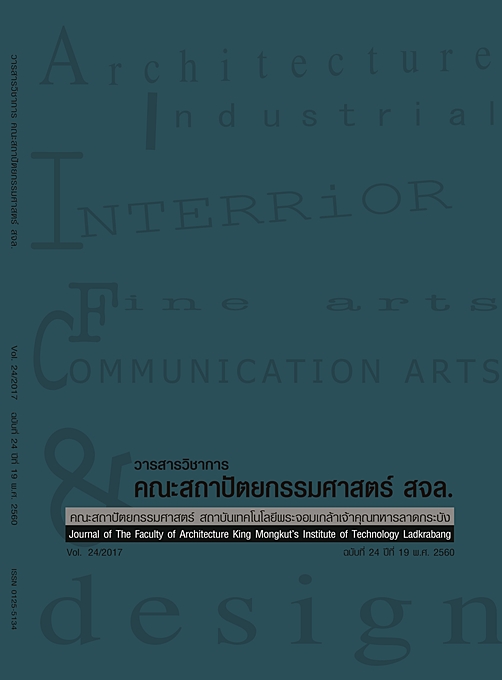การออกแบบและก่อสร้างศาลาด้วยโครงสร้างเหล็ก: โครงการพัฒนาพื้นที่ริมน้ำวัดโสธรวรารามวรวิหาร Design and Construction of Pavilion with Steel Structure: Waterfront Development Project, Wat Sothon Wararamworawihan
Main Article Content
Abstract
บทคัดย่อ
งานวิจัยการออกแบบและก่อสร้างศาลาในโครงการพัฒนาพื้นที่ริมน้ำวัดโสธรวรารามวรวิหาร จังหวัดฉะเชิงเทรานี้มีวัตถุประสงค์เพื่อศึกษาการประยุกต์ใช้วัสดุเหล็กรูปพรรณกลวงเป็นโครงสร้างหลักของศาลาที่มีการตกแต่งปูนปั้นสถาปัตยกรรมไทยวิธีการศึกษาและขั้นตอนการดำเนินการวิจัย 1) ทำการสำรวจพื้นที่ริมแม่น้ำบางปะกงวัดโสธรวรารามวรวิหาร 2) บันทึกภาพขั้นตอนการก่อสร้างศาลาจำนวน 6 หลัง และหลังคาคลุมทางเดินระหว่างศาลาในช่วงเดือนมีนาคม 2558 ถึงเดือนพฤศจิกายน 2559 3) สัมภาษณ์ช่างก่อสร้างงานโครงสร้างเหล็ก ช่างปั้นปูนและพระสงฆ์ผู้มี ประสบการณ์บริหารงานก่อสร้างวัด 4) ศึกษาและวิเคราะห์เอกสารอ้างอิงเกี่ยวกับหลักวิธีการออกแบบสถาปัตยกรรมไทย
ผลการวิจัยพบว่าการนำโครงสร้างเหล็กมาใช้ในงานสถาปัตยกรรมไทยมีความเป็นไปได้ ช่วยลดขั้นตอน อีกทั้งประหยัดเวลาและประหยัดงบประมาณเมื่อเปรียบเทียบกับวิธีการก่อสร้างแบบทั่วไป การตกแต่งลวดลายปูนปั้นบนโครงสร้างเหล็กสามารถผลิตเป็นชิ้นส่วนหล่อสำเร็จแทนการปั้นปูนสดซึ่งต้องอาศัยช่างฝีมือที่มีความชำนาญเฉพาะทางและใช้เวลามากกว่าประเด็นข้อเสนองานวิจัย 1) พัฒนาการก่อสร้างเป็นระบบอุตสาหกรรมโดยใช้เทคโนโลยีที่เหมาะสม 2) ประยุกต์เป็นแบบมาตรฐานสำหรับอาคารสาธารณะประเภทศาลา และ 3) เป็นแบบก่อสร้างให้กับหน่วยงานที่เกี่ยวข้องการพัฒนาพุทธศาสนสถาน
คำสำคัญ: ศาลา โครงสร้างเหล็ก วัด
Abstract
The objective of this research is to study how the structural hollow steel can be applied to be themain structure of the traditional Thai pavilion with stucco architecture. The research design and construction has taken place at the waterfront development project at Wat Sothon Wararamworawihan, Chachoengsao province. The research methodology and processes include: 1) conduct an area survey alongside the Bang Pakong river where Wat Sothon is located; 2) take photos of six pavilion construction projects including the walkway area during March 2015 to November 2016; 3) conduct oral interviews with steel construction workers, stucco workers, and an experienced monk who previously has managed temple constructions in the past; and 4) Conduct thorough studies and analyse Thai architectural design.
The research found that there was a possibility of bringing structural steel to use in the Thai architecture as it helps simplify the process and save time when and budget compared to the conventional construction methods. The research also found that producing finished precast pieces of stucco is better than making fresh plaster molding, which requires skilled craftsmanship and time-consuming installation. Recommendations are: 1) elevate the use of steel structure to industry level by applying the appropriate technology; 2) employ this technique as a new standard of building public pavilion; and 3) be a prototype for relevant organizations when developing or improving Buddhist monasteries.
Keywords: Pavilion, Steel Structure, Temple
Article Details
This work is licensed under a Creative Commons Attribution-NonCommercial-ShareAlike 4.0 International License.
Copyright Transfer Statement
The copyright of this article is transferred to Journal of The Faculty of Architecture King Mongkut's Institute of Technology Ladkrabang with effect if and when the article is accepted for publication. The copyright transfer covers the exclusive right to reproduce and distribute the article, including reprints, translations, photographic reproductions, electronic form (offline, online) or any other reproductions of similar nature.
The author warrants that this contribution is original and that he/she has full power to make this grant. The author signs for and accepts responsibility for releasing this material on behalf of any and all co-authors.

